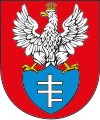Legionowo
| Legionowo | ||
|---|---|---|

|
|
|
| Basic data | ||
| State : | Poland | |
| Voivodeship : | Mazovia | |
| Powiat : | Legionowo | |
| Area : | 13.56 km² | |
| Geographic location : | 52 ° 24 ' N , 20 ° 57' E | |
| Height : | 75 m npm | |
| Residents : | 54,049 (Jun. 30, 2019) |
|
| Postal code : | 05-118 to 05-122 | |
| Telephone code : | (+48) 22 | |
| License plate : | WL | |
| Economy and Transport | ||
| Street : | DK61 : Pułtusk - Warsaw | |
| Rail route : | Warsaw – Nasielsk | |
| Legionowo – Tłuszcz | ||
| Next international airport : | Warsaw | |
| Gmina | ||
| Gminatype: | Borough | |
| Residents: | 54,049 (Jun. 30, 2019) |
|
| Community number ( GUS ): | 1408011 | |
| Administration (as of 2007) | ||
| City President : | Roman Smogorzewski | |
| Address: | ul. Piłsudskiego 3 05-120 Legionowo |
|
| Website : | www.legionowo.pl | |
Legionowo is a city in Poland in the Masovian Voivodeship .
geography
The city is located about 23 kilometers northwest of Warsaw .
history
The city's history does not go far back into the past. 1877 was the railway station "Jabłonna" built what was the beginning of the colonization of the area. The station was built for the construction of the railway line, which, among other things , should ensure the transport of wheat to the Baltic Sea ports . The name of the settlement was initially Gucin , which goes back to Count August Potocki . In 1885 there were just five wooden villas in the settlement. A significant development of the city began in 1892 when a Russian garrison was established, Russia bought part of the area from the count and had barracks built. In 1897 a glassworks , mainly for the production of beer bottles, was built, which was another important factor in the development of the city. In 1899 4,000 soldiers were stationed in the garrison . At the beginning of the 20th century, around 60 people lived in the place. Due to the rapid development of the place, the city received the status of a rural community with the financial law of a city on March 17, 1930 by the Minister of the Interior in consultation with the Minister of Finance. In the 1930s the city had a post office, four general education schools, a commercial school, and a state meteorological institute . With the restoration of Poland's independence after the First World War , the garrison was also used by Polish soldiers. The 1st and 2nd regiments of infantry of the “Polish Legion” were the new residents of the barracks. After the Polish-Soviet war was, among others, into the barracks balloon - battalion stationed. On September 13, 1939, the first soldiers of the German Wehrmacht reached the place. On October 28, 1944, the Red Army took the place. On May 3, 1952 Legionowo received city rights .
From 1975 to 1998 the municipality was part of the Warsaw Voivodeship .
Population development
| year | 1925 | 1931 | 1944 | 1975 | 1980 | 2000 |
| population | 658 | 8,856 | 9,860 | 21,800 | 40,000 | 51,650 |
traffic
At Legionowo station, the Legionowo – Tłuszcz line branches off from the Warszawa – Gdańsk line .
coat of arms
Today's coat of arms was adopted at a meeting of the city council on November 22, 2000. The stylized crowned eagle in the center of the coat of arms is intended to remind of the time when the name of the city was received. In 1919, with the resurrection of the Polish state, the barracks were given the name Legionowo . The eagle is supposed to remind of the military roots of the place. The cross below the eagle refers to the coat of arms of Pilawa .
Town twinning
sons and daughters of the town
- Wojciech Lemański (* 1960), Polish clergyman and critic of the Catholic Church
- Mariusz Błaszczak (* 1969), Polish politician, Minister of the Interior and Defense
- Jarosław Fojut (* 1987), Polish footballer
Web links
Individual evidence
- ↑ a b population. Size and Structure by Territorial Division. As of June 30, 2019. Główny Urząd Statystyczny (GUS) (PDF files; 0.99 MiB), accessed December 24, 2019 .
- ↑ Dz.U. 1975 no 17 poz. 92 (PDF; 802 kB, Polish).

